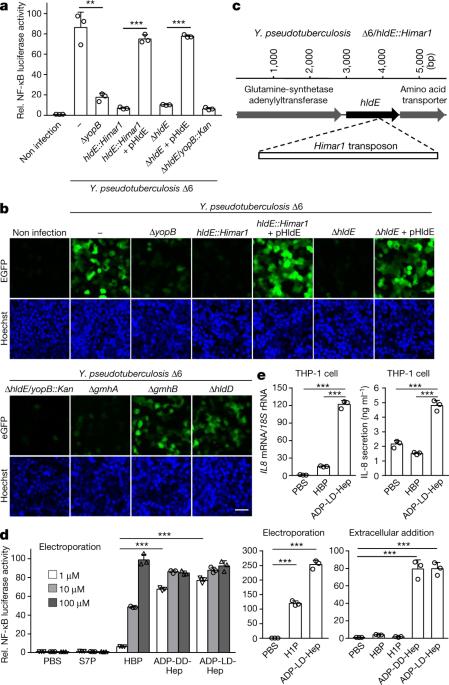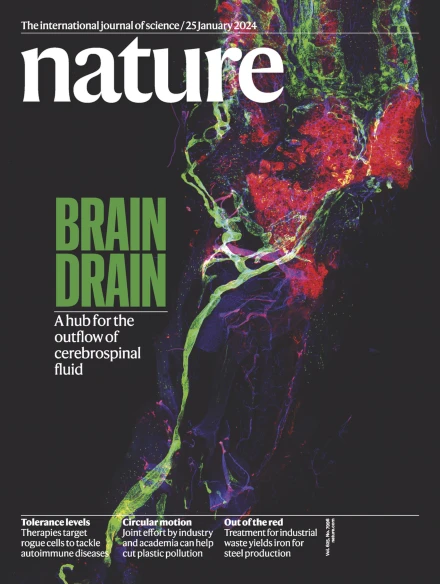Alpha-kinase 1 is a cytosolic innate immune receptor for bacterial ADP-heptose
IF 48.5
1区 综合性期刊
Q1 MULTIDISCIPLINARY SCIENCES
引用次数: 142
Abstract
Immune recognition of pathogen-associated molecular patterns (PAMPs) by pattern recognition receptors often activates proinflammatory NF-κB signalling1. Recent studies indicate that the bacterial metabolite d-glycero-β-d-manno-heptose 1,7-bisphosphate (HBP) can activate NF-κB signalling in host cytosol2–4, but it is unclear whether HBP is a genuine PAMP and the cognate pattern recognition receptor has not been identified. Here we combined a transposon screen in Yersinia pseudotuberculosis with biochemical analyses and identified ADP-β-d-manno-heptose (ADP-Hep), which mediates type III secretion system-dependent NF-κB activation and cytokine expression. ADP-Hep, but not other heptose metabolites, could enter host cytosol to activate NF-κB. A CRISPR–Cas9 screen showed that activation of NF-κB by ADP-Hep involves an ALPK1 (alpha-kinase 1)–TIFA (TRAF-interacting protein with forkhead-associated domain) axis. ADP-Hep directly binds the N-terminal domain of ALPK1, stimulating its kinase domain to phosphorylate and activate TIFA. The crystal structure of the N-terminal domain of ALPK1 and ADP-Hep in complex revealed the atomic mechanism of this ligand–receptor recognition process. HBP was transformed by host adenylyltransferases into ADP-heptose 7-P, which could activate ALPK1 to a lesser extent than ADP-Hep. ADP-Hep (but not HBP) alone or during bacterial infection induced Alpk1-dependent inflammation in mice. Our findings identify ALPK1 and ADP-Hep as a pattern recognition receptor and an effective immunomodulator, respectively. The bacterial metabolite ADP-heptose activates NF-κB in host cells via alpha-kinase 1 and the TIFA–TRAF signalling pathway.

α-激酶1是细菌ADP-庚糖的细胞膜先天免疫受体
模式识别受体对病原体相关分子模式(PAMPs)的免疫识别通常会激活促炎性 NF-κB 信号1。最近的研究表明,细菌代谢产物 d-甘油-β-d-甘露-1,7-庚糖二磷酸(HBP)可激活宿主细胞质中的 NF-κB 信号2-4,但目前尚不清楚 HBP 是否是真正的 PAMP,也未确定其同源的模式识别受体。在这里,我们将假结核耶尔森菌中的转座子筛选与生化分析相结合,发现了 ADP-β-d-manno-heptose (ADP-Hep),它能介导依赖于 III 型分泌系统的 NF-κB 激活和细胞因子表达。ADP-Hep能进入宿主细胞质激活NF-κB,而其他庚糖代谢物则不能。CRISPR-Cas9筛选显示,ADP-Hep对NF-κB的激活涉及ALPK1(α-激酶1)-TIFA(具有叉头相关结构域的TRAF相互作用蛋白)轴。ADP-Hep 直接结合 ALPK1 的 N 端结构域,刺激其激酶结构域使 TIFA 磷酸化并激活。ALPK1 N-端结构域与 ADP-Hep 复合物的晶体结构揭示了这一配体-受体识别过程的原子机制。HBP 被宿主腺苷酸转移酶转化为 ADP-heptose 7-P,后者对 ALPK1 的激活程度低于 ADP-Hep。ADP-Hep(而非 HBP)单独或在细菌感染期间可诱导小鼠发生 Alpk1 依赖性炎症。我们的研究结果表明,ALPK1 和 ADP-Hep 分别是一种模式识别受体和有效的免疫调节剂。细菌代谢物 ADP-庚糖通过α-激酶 1 和 TIFA-TRAF 信号通路激活宿主细胞中的 NF-κB。
本文章由计算机程序翻译,如有差异,请以英文原文为准。
求助全文
约1分钟内获得全文
求助全文
来源期刊

Nature
综合性期刊-综合性期刊
CiteScore
90.00
自引率
1.20%
发文量
3652
审稿时长
3 months
期刊介绍:
Nature is a prestigious international journal that publishes peer-reviewed research in various scientific and technological fields. The selection of articles is based on criteria such as originality, importance, interdisciplinary relevance, timeliness, accessibility, elegance, and surprising conclusions. In addition to showcasing significant scientific advances, Nature delivers rapid, authoritative, insightful news, and interpretation of current and upcoming trends impacting science, scientists, and the broader public. The journal serves a dual purpose: firstly, to promptly share noteworthy scientific advances and foster discussions among scientists, and secondly, to ensure the swift dissemination of scientific results globally, emphasizing their significance for knowledge, culture, and daily life.
 求助内容:
求助内容: 应助结果提醒方式:
应助结果提醒方式:


